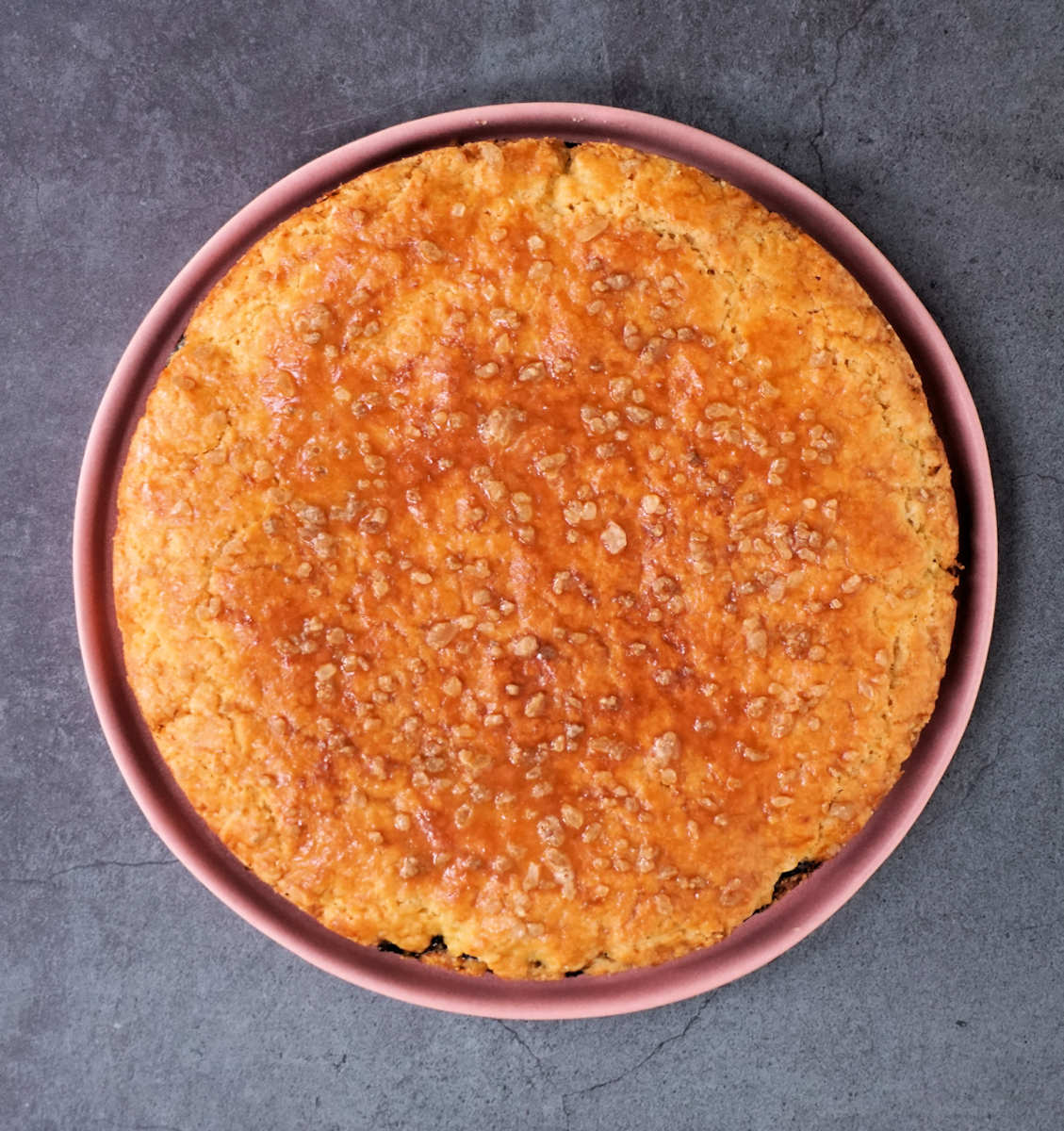Basque cake, called le gâteau Basque on the French side and pastel vasco in Spain, is a rich, buttery tart which comes plain or with a creamy or fruity filling.

Pays Basque and Brittany
It is interesting how two quite remote French regions have very similar local specialities.
Brittany and Pays Basque each have their own version of round, buttery and melting, sweet shortcrust tarts. It is definitely not a competition and I’m not favouring one over the other!
But I might say, at the risk of my friendship with both sides, that they are almost the same confection.
There are some slight differences. Breton cake is richer in eggs and made with salty, native, hand churned butter. Gâteau Basque is a little more austere and made with melted, cooled butter, thus making the pastry very easy to mix by hand.
Both boast a swirly pattern (or in the case of the Basque: lauburu) on top, rendered in extra egg yolk.
Origins of Basque cake
It is called etxeko bixkotxa in Basque which simply means ‘house cake’. Invented in the 19th century by a pastry chef from Cambo-les-Bains, Marianne Hirigoyen, it was originally called gâteau de Cambo.
These days you can’t enter a bakery in the Basque country without encountering a large wheel or individual discs of etxeko bixkotxa.
It even has its own museum in Sare where you can learn all about the recipe, the history and – most importantly – taste the cake at all stages of the making.
Basque cake fillings
The cake sometimes comes plain, but most often it is filled with pastry cream, jam or confiture.
Black cherry jam is the most traditional fruit filling, but I love it with crème de pruneaux, prune paste.
And it’s perfectly fitting considering that Agen, the famous locality for prunes, is just around the corner from Pays Basque.
How to make the prune filling
Crème de pruneaux is just divine and so worth doing, I’ll sulk if you fill your gâteau with plain jam. It is also a complete breeze to make so no excuses.
Agen prunes are undoubtedly the best but use any fresh (as in, not anciently dried out and ossified), soft, pitted prunes.
All they need is ten minutes of lively simmering with some water, very little sugar and a bit of cinnamon. They will marvellously turn into thick, spreadable jammy paste, black and gorgeous.
How to make the Basque pastry?
This is super easy, and it actually comes out much better when mixed by hand, rather than using mixers and processors.
All you need to do is stir the dry ingredients, the flour, baking powder, salt, sugar and grated lemon zest in a large bowl.
To that the whole egg and yolks are whisked in, making the whole thing lumpy and clumpy, but fear not: once the melted, cooled butter goes in it will meld together.
That’s best kneaded lightly by hand, like shortcrust pastry or a scone mix and you needn’t be terribly brisk – Basque pastry is resilient.
Once you’ve formed a ball, split it in two. If your tin has a loose bottom, use it as a template to roll out two pastry rounds. Leave the second one in and shape a slight rim around the edge.
Spoon the filling in and slip it all into the tin. Place the top pastry layer over the filling, using a pizza peel or a rimless baking sheet.
Not to worry about sealing the edge – this filling stays put and doesn’t leak.
You can brush the top with the extra egg yolk whisked with a spoonful of water, and sprinkle some coarse sugar crystals, but that’s all optional.
Baking and storing
Do not overbake your gâteau Basque, it will become crumbly and dry. Forty-five minutes is perfect in a standard, non-fan oven. The cake should be pale golden brown and crisp around the sides.
Leave it in the tin to cool completely, before releasing it with the help of a palette knife: the filling doesn’t leak but it does stick to the sides.
Keep it on a covered cake stand, in a cake box or loosely wrapped in foil. It will stay fresh and wonderful for at least three or four days.
More Basque recipes
Mouchous, traditional macarons basques, are easier to make than the Parisian variety but just as delicious though presented individually and quite rustic compared to Paris macarons.
Piperade is the Basque take on ratatouille with the heat of espelette pepper. This recipe is easy and simple, like a lot of best things in life.
More French pastry recipes
Apricot frangipane tart, delicious summer dessert. Fresh apricots on easy frangipane layer, with a lovely shortcrust pastry base. The most versatile recipe for a summer tart.
Tradition has it that a galette des rois, a kings’ cake, should hide a ‘feve’ - a small figurine of a king or angel, sometimes replaced by an almond or a bean. Also traditionally it is eaten on fete des rois, or celebration of Epiphany, on 6th January.
Chocolate sable biscuits with raw cocoa nibs and sea salt flakes. Meltingly tender biscuits with wonderfully crunchy cocoa nibs – these are grown-up choc chip cookies.